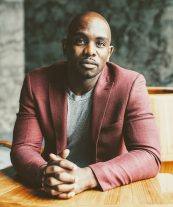The new chair of the Dutch Design Awards main jury this year is Kevin de Randamie, a passionate connector pur sang. “If anything is universal, it’s music. Design is perhaps a different animal, but I’d like to contribute to the interweaving of creative and business networks.”

Kevin de Randamie (45) is originally a hip-hop artist, known as Blaxtar. In 2006 he independently released his first album Ozmoses, on his own label. “People around me were getting record deals and when I looked at them,
I thought, ‘there’s got to be another way of doing this’. Why do we accept a construction in which you’ve already lost eighty percent of your turnover, with hardly any guarantees in return?”
First yourself
“My point was: a label can be really valuable, but I want to know exactly what it is. So I tried it first myself. This approach is still the wave underneath my surfboard. I can safely say that it generated quite a few shockwaves that led to what I’m doing now with Cre8tive Revolution: helping people create their own conditions for their creative or artistic work, while maintaining the financial value of that work.” He describes Cre8tive Revolution as a community business, where creatives learn how to determine the value of their work and how to increase that value. In practice, he sees a lot of misinformation. “Unfortunately, I think there’s still not enough happening with this in creative education. Lots of makers leak value through incorrect assumptions. There is a myth that foundations aren’t allowed to generate profit, for example, or that setting up a limited company is really expensive or complicated. It is such an incredible waste of all the wonderful creative ideas if they are not given the space to grow to their full potential. I want to do something about that. And I see DDA in exactly that vein.”
Mature choices
“As a designer or creator, your art is often an extension of yourself. Entering into professional life in this way is bound to give rise to unhealthy situations. Unless you are lucky enough to come from an entrepreneurial family, you won’t be prepared to enter the field of work as a designer or artist. It’s good to bring in people who know what they’re doing, but how can you assess the skills of a financial expert if you don’t know anything about finances yourself? This expert may have the best intentions in the world, but there is no equality, because you’re sparring with someone who does that for a living. And you are the one who must make mature choices about your own creative practice.”
“And on top of that: everyone’s against exploitation, until you have to pay the bill yourself. Who benefits from your understanding of your value as a designer? And so, a whole lot of human, creative and economic capital is wasted. But this is no longer the case, thankfully. Here too, I also see a great role for DDA: as a glimpse into the future of our creative potential.”
— ‘I see a clear respect for the purpose of design’
More inclusive design field
“Dutch Design Awards approached me very openly with a request to think about taking steps towards inclusiveness. By giving this topic the necessary attention, DDA pays service to itself as an institute but also to the sector. We often look to network organisations when we want to tackle inclusivism. But let’s be honest: even if everyone did it, there aren’t enough people with a bi- or tri-cultural background to fill all the positions. In the professional field you usually come across enough, but towards the top of any organisation it quickly becomes whiter and whiter. This is the case in lots of professions, even in music, which is strange because if anything is universal, it’s music. Design may be a different animal, but you still see the same there, just like in so many other sectors. I really want to make my contribution to the interweaving of creative and business networks. And above all, I’m triggering my own clients to move out of their comfort zone, so I walk the talk.”
Conscious design
“I believe you can’t overestimate the value of design. Every day, designers give shape to just about everything we come in contact with: systems, art, clothing, finances, buildings, solutions and even most problems: they are all designed by someone. The concept of design is to shape life; everything is creation.”
“What struck me while judging was that the whole process was set up very professionally. It ran smoothly and there was space for everyone’s perspective, even though the main jury was still a relatively homogeneous group, which fits with the image I have of the field. It was nice to see a much greater diversity in the entries and professional juries. This shows that the movement has started; this year’s nominees are the best examples of this. A different kind of circle has different discussions and makes different decisions. I used to associate design mainly with aesthetics, but it is now much more about design thinking. I also saw this reflected in the jury process; there was a clear respect for the purpose. Not everyone had the same opinion, but they did agree on why what we do is relevant.”